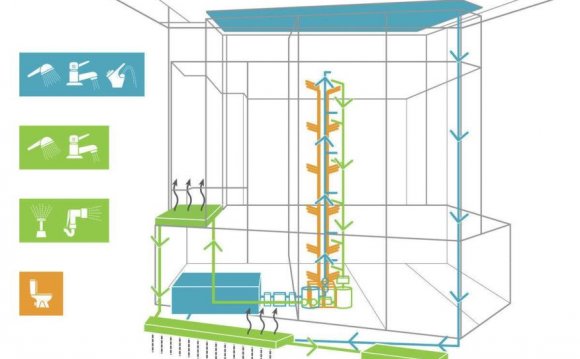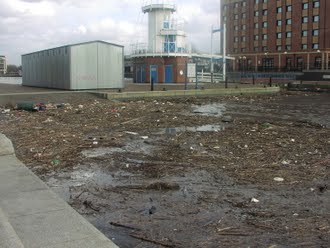
Industrial operations produce a liquid product that almost always must be treated before being returned to the environment. There are three different groups of wastewater to be considered.
Classifications of Waste Water
- Domestic waste waters
- These waters are produced by the mere acts of living such as using the bathroom, doing laundry, or washing the dishes. These wastes are normally handled by the sanitation department, which eliminates pathogens before disposal.
These waters are produced by some industrial processes and include the undesired liquid product of any unit operation. The major concern with these wastes is the reactions that may occur with the environment being either direct or indirect. Some may rob oxygen from the environment, while others may be toxic.
- Process waste waters
- Cooling waste waters
These waters are produced as a result of some sort of heat exchanger where heat is removed from the product. Waters can be used once or recycled. Recycling creates the necessity for periodic cleaning, where at least some may be released into the environment. This is the least dangerous the waste waters, but because of leaks within the process, could contaminate the surroundings. This type of waste must also be monitored and often treated, and is also a major factor in thermal pollution of water sources.
The Characteristics of Waste Water
- Priority Pollutants
- These are directly regulated on a basis of toxicity. Government regulation required permits and inspections. All priority pollutants are toxic. They include heavy metals, PCB's and various forms of benzene compounds. For a complete listing see Industrial Water Pollution Control, by Eckenfelder, W. W. Jr., 2nd Edition, McGraw Hill, NY, 1989.
These can vary from proteins to solvents, and most industries produce several different streams. It is important to note in design that side reactions also need to be considered. One way to measure the "strength" of an organic was is the 5-day biochemical oxygen demand (BOD5). This measures the demand for dissolved oxygen by the microbes that attack the organics within a specified volume over a 5-day period.
- Organics
These are a combination of the inorganics coming in and the direct result of any reaction that produces inorganics, or the addition of inorganics within a process. It is important to note that a balance is needed before this liquid is returned to the environment.
- Inorganics
Chemical reactions and additions to the process tend to either increase or decrease the pH and alkalinity of a solution. The pH must be regulated to between 6 and 9 for little impact upon discharge.
- pH and Alkalinity
Due to biological treatment, if required, the temperature of wastewater should be kept between 10 and 30 C if possible. This is due to the optimum temperature that microorganisms function at.
- Temperature
Aquatic life requires a certain amount of D.O. to survive. Therefore there are maximum levels, which can also be lethal, and minimum levels of D.O. that must be met before discharge can occur.
- Dissolved oxygen
This includes volatile and nonvolatile solids either suspended or dissolved in the wastewater. These may be either organics or inorganics. A certain percentage of total solids must be met before discharge.
- Solids
These may cause biological activity in the discharge area to increase, which will inherently lower the amount of D.O. in the system. This directly affects the amount of life that can be sustained within the area.
- Nutrients
- Oils
These compounds may interfere with oxygen transfer within aquatic life. It also leads to a poor appearance due to the insolubility.
Treatment
There isn't a standard design to treat all wastewaters due to the characteristics of the process specific waste. Each site requires a design specific to the process at hand, but some combination of the following pretreatment, primary treatment, secondary treatment, and processing are normally used. As a rule of thumb, we would like to separate several pollutants in one step and use several steps to increase the degree of treatment.
The Pretreatment Process
This is very widely used as it may drastically cut down overall treatment costs.
- Equalization
This is the process of adjusting the concentration of wastes, flow of wastes, mixing, oxygen characteristics, temperature, and so on.
- Neutralization
This is the process of adding materials, mixing and adjusting pH measurements for the bulk of the discharge to adequate values.
- Oil Removal
Due to solubility characteristics, we can separate oils by gravity, or something as simple as skimming. We can also add chemicals to break down or separate oils.
- Toxin Removal
These must be separated from the discharge to insure that federal guidelines are met. Chemical addition and reaction can often aid in the separation.
The Primary Treatment Process
The goal of primary treatment is to remove solids by chemical or physical methods.
- Screens
Various types are currently being used to filter particulate matter from the solution. Machines may be used to keep the screens clean and clogging is a frequent problem.
- Grit Chambers
Here hard inert particles are separated using a mixing pattern where air provides a circular current and inerts settle to the bottom of the chamber, are picked up in a screw drive conveyer and are carried off for disposal. This process resembles a centrifuge, and provides fast separation.
- Gravity Sedimentation
This process is used for materials with slower settling times. They are designed on the basis of the retention time necessary for adequate waste removal. Operation is essentially the same as for the grit chamber, except in flow rates are much slower, and a scum layer can be removed from the surface due to poor mixing.
- Chemical Precipitation
A coagulant is added to suspend solids for removal by sedimentation. However, it increases the amount of sludge that must be processed.
The Secondary Treatment Process
The main concept behind secondary treatment is the use of microorganisms to break down components of the waste into less damaging forms.
RELATED VIDEO




 Water pollution is the contamination of water bodies (e.g. lakes, rivers, oceans, aquifers and groundwater). Water pollution occurs when pollutants are discharged directly or indirectly into water bodies without adequate treatment to remove harmful compounds.
Water pollution is the contamination of water bodies (e.g. lakes, rivers, oceans, aquifers and groundwater). Water pollution occurs when pollutants are discharged directly or indirectly into water bodies without adequate treatment to remove harmful compounds. Wastewater, also spelled waste water, is any water that has been adversely affected in quality by anthropogenic influence. It comprises liquid waste discharged by domestic residences, commercial properties, industry, and/or agriculture and can encompass a wide range...
Wastewater, also spelled waste water, is any water that has been adversely affected in quality by anthropogenic influence. It comprises liquid waste discharged by domestic residences, commercial properties, industry, and/or agriculture and can encompass a wide range...








